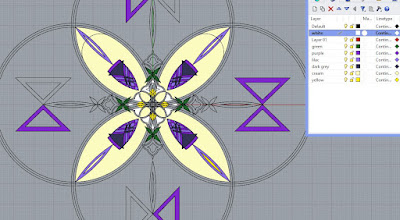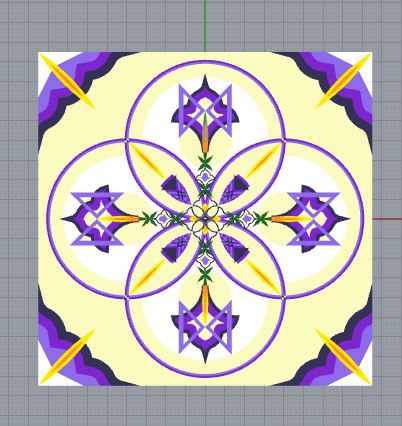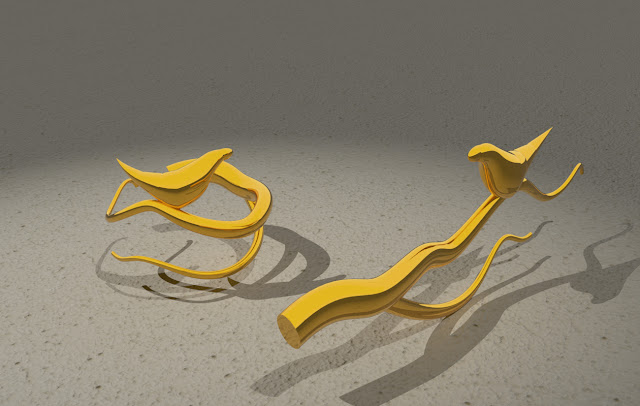Patterns in Life
At first I wasn't sure I was going to be able to find enough surface design patterns around my house to get a good sample...but once I started looking I kept finding more and more.
Using array and knowing the dimensions of my square design, it was easy to duplicate and align my pattern without overlap or gaps. I feel like I hit my intentions pretty squarely - there is a lot of meaning within the design, specifically linking to Indigeneity - connections, relationships between elements, nature, markers of strength, the stars - and a teeny tiny medicine wheel in the centre. I could easily wear this at a powwow, or as part of a contemp urban Indigenous hoodie yet the European elements - like the gothic feeling overlapping circles and the fleur de lis' don't compete or feel out of place.
Love this shirt on my partner - did not feel like I had enough time in my life to attempt to replicate it though
This pattern was neat but too organic to replicate at my skill level
After locating the samples, I booted up rhino and began to attempt to replicate the patterns I had found, starting with the simpler patterns that drew my eye.
the pattern from our laundry basket and some variations
based on the carved candle holder
exploring Pendleton-like designs
a floral motif from a plate
After replicating sections of designs, I started to have a concept - of integrating some of the disparate elements of my life together. As a biracial person, both Indigenous art and western art are parts of my life and experience - and I am capable of making both separately. This time I wanted to create something that seamlessly merged the contemporary Canadian experience, my childhood in Europe and my Indigenous culture. (Shout out remix culture!)
I value my ribbon skirt highest from all the samples, so I chose to create a pattern that would fit a ribbon skirt or kokum scarf. I created a palette that was similar, with harmonious colour but also a range of values to allow for contrast - it would suck if I couldn't make important elements stand forward from the pattern, and I wanted some boldness.
Starting with the fleur de lis/ acorn shape - something very familiar from European design across the centuries, I began a pattern from 0 on the board. Creating from this point using a pattern that reflected easily made certain tasks very simple - I could rotate and arraypolar to replicate my work around the circle easily. Although I could have worked in just one quad knowing the work would be replicable, I valued being able to see the pattern emerge - this is a new process for me and I wanted to be sure of how key elements would look.
The Indigenous patterns tended towards geometric and angular, but the refined floral European patterns I had in mind leaned towards arcs, curves and flourishes. Contemp western as sampled mixed both - geometry and circles. I worked through solutions until I found a mix that appealed to me, while being reminiscent of my sources. I incorporated elements of nature, but changed the crossed arrow pattern on the skirt to four bullet shapes.This felt quite western and I wasn't surprised to notice that.
For a portion of the process, I worked with the top circle containing text - wahkomâkanak in Cree syllabics. I was surprised by how easy it was to create the syllabics shapes. Ultimately I removed this portion and rotated in one of the other circles, as I didn't feel it contributed to the pattern. I did keep the triangles which are the letters O and A in syllabics, because I felt they provided a link to the triangles so heavily used in pendleton design.
The finished pattern segment
I created a little corner piece, knowing it would create a star effect in the dead space between the four-hoops shapes. This was easily duplicated through polar array.
Yes, hatching took a while, but being methodical and designing with polar array in mind saved me a lot of time, and I would certainly do this again. I look forward to hearing how this will be fabricated - as I suspect I may need to change elements based on the size we are going to replicate at, due to some of the small and fiddly pieces- but I feel confident I can do so while maintaining the balance I have found.

























OMG JILLL I LOVE THIS.
ReplyDeletethank you! <3
Delete